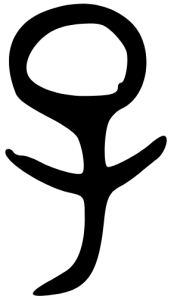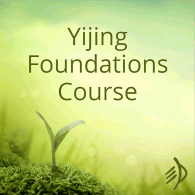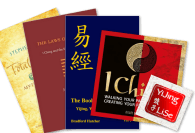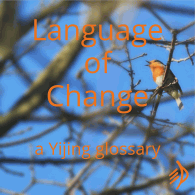
Where you find the noble one
We mostly come across the junzi, the ‘noble one’, in the Image Wing of the Yi. But he also features in many oracles and lines of the original text. Here’s the whole list:
1.3, 2.0, 3.3, 9.6, 12.0, 13.0, 15.0, 15.1, 15.3, 20.1, 20.5, 20.6, 23.6, 33.4, 34.3, 36.1, 40.5, 43.3, 49.6, 64.5
That’s interestingly different from the daren, the ‘great person’, who shows up in line 2 or 5 in five out of his six appearances in line texts. The great person stands at the centre, but the noble one is more likely to be at line 3 or 6 than anywhere else. He seems to be pushing at the learning edge of things.
That fits with the original meaning of the character: the noble young one. Jun 君 means ruler – the old character shows a mouth and a hand wielding a staff= – and zi 子 means a child – in the ancient character, a baby. That’s not just some generically ‘superior man’, but specifically someone who’s growing.
At least, that’s how it seems to me when I read through the story of the noble one as it unfolds through the Sequence of hexagrams.
The noble one through the Sequence
Hexagrams 1-9: the active learner
He (or she, but I’ll stick to one pronoun here to avoid sounding silly) appears first of all at 1.3, full of creative energy and wound too tightly to sleep:
‘Noble one creates and creates to the end of the day,
At nightfall on the alert, as if in danger.
No mistake.’
Then in hexagram 2 he has a direction to go, is confused at first and later finds guidance (a ‘lord’, literally a lamp with its flame).
At 3.3, he manages not to chase the deer into the forest and get lost. And similarly at 9.6, it will mean misfortune if he sets out to bring order.
This junzi seems to be energetic, active, eager – and learning to pay attention to time and place before he acts. It’s OK to be too excited to sleep, but perhaps it will prove better to follow guidance, better not to run off without any, and much better not to try to bring perfect order at a time when it’s already rained.
The lessons of 12 and 13
We’re building up to the painful lesson of Hexagram 12: creative imagination, strength and uprightness, all his good qualities, are not always going to help matters.
‘Blocking it, non-people.
Noble one’s constancy bears no fruit.
Great goes, small comes.’
(This can actually be quite a consoling reading, because if even a noble one’s constancy bears no fruit, then the obstacle isn’t caused by your own deficiencies.)
However –
‘People in harmony in the wilds: creating success.
Fruitful to cross the great river.
A noble one’s constancy bears fruit.’
– look what has changed in Hexagram 13! Not the constant noble one, but his surroundings, or perhaps his relationship to them. Where there is harmony, movement, fellowship and mutual awareness (see the change of the inner trigram), then his constancy will bear fruit.
15 and 20: growing awareness
He appears next in hexagram 15, three times. Here, he seems to assimilate his experiences so far – to understand his own strengths and limits in a larger context. With that awareness, he can do his work, bring things to completion.
He has another three appearances in hexagram 20 – another key stage of his evolution, I think, as he develops a larger awareness. From this point on, he’s going to be more capable of looking into the future. Here for the first time, he’s different from ‘small people’:
‘A child seeing.
For small people, no mistake.
For a noble one, shame.’
The noble one now – in lines 5 and 6 – can see a life as a whole, not just from a child’s perspective.
Hexagram 23 and beyond: a creative adult
As an adult, the noble one must see further and do more than the small people: get a cart to travel onward while they only sabotage their huts; retreat with love; use a net where they only know how to use strength. And it seems he will also go beyond what’s expected or acceptable – he travels alone, gets talked about, gets soaked.
(This is a step beyond the learning of 3.3 or 9.6 or 12-13: what he can achieve depends on circumstances and other people’s dispositions, but what he should undertake does not.)
He can find freedom and be true within his bonds. And – unlike his younger self back at 9.6 – now he can see the possibility of settling down with the change achieved rather than pressing on disastrously for more:
‘Noble one transforms as a leopard,
Small people radically change their faces.
Setting out to bring order: pitfall.
Settling with constancy: good fortune.’
That’s almost the last we see of him; he gets no mention in the 50s. (I don’t know why not.)
Radiant junzi
The noble one’s final appearance is in the penultimate line of the whole book:
‘Constancy, good fortune, no regrets.
A noble one’s radiance.
There is truth and confidence, good fortune.’
Well! The noble one of 2.0 needed a master, a lamp-person to follow; this one shines out himself, like a beacon of truth.
(I think the connection through this line change back to hexagrams 6 and 5 is important: in 5 there is also ‘truth and confidence’ and ‘radiance’, in 6 truth and confidence is blocked and you need to see the great person. Perhaps a future or higher self is reaching back through the decades of hexagrams to help a conflicted younger self…?)
Reading the story
I think all this sketches out a story of development.
The junzi starts out full of energy, knowing where he’s going and what he wants. First he must learn not to overdo things, to recognise the quality of the time before he applies his creative energies; then he can do his work.
He develops vision; he has to act more imaginatively than the small people, to see possibilities invisible to them. And as his awareness develops, he even becomes responsible for departing from the norms when the norms are wrong: his personal integrity should go beyond circumstances. He undergoes personal transformation, and embodies the possibility of change himself.
It’s an interesting story to ponder when the Zhouyi’s noble one shows up in a reading.









Thanks, yes it is interesting since I had never even realised the noble one was not the same as the great person….that is hardly ever noticed the phrase ‘noble one’ before. I will be noticing where it crops up now.
BTW I thought the little character drawing reminded me of something, couldn’t quite place what it was….Have just realised it reminds me of ‘Sooty’, you know the puppet from ‘Sooty and Sweep’. Sooty was quite noble actually.
Ah yes – of course it’s Sooty. Sootyzi, the sage of the eponymous show. For more information, see http://www.thesootyshow.com/ .
Well if the characters for ‘woman’s constancy’ in anyway resemble Soo, or for ‘Fei Ren’ resemble Sweep, then I think we do have the basis for an alternative I Ching.
Interesting that the noble one should appear mostly in lines three and six as those are lines that often present the greatest challenges, at least in terms of excess, and the lines that often show a situation that has gone too far. Line three is attempting to enter the upper trigram, and may or may not fail. Line six has gone beyond the norm and is normally challenging, (depending on the situation) although in some cases, in several cases, line six has left the earthly realm and has entered the heavens, and faces new challenges in the great beyond. Line six often lies outside the affairs of the world. But all these things are merely contextual and can have many different applications.
Gene
I thought – or read or heard or whatever – that the junzi is similar to our “young mister Grace” or the young lord or such terms. The son of the grownup noble. He has the background, but needs to learn and get experience.